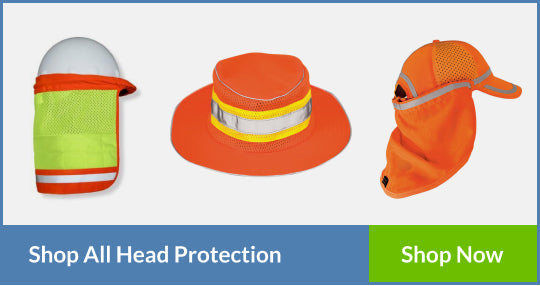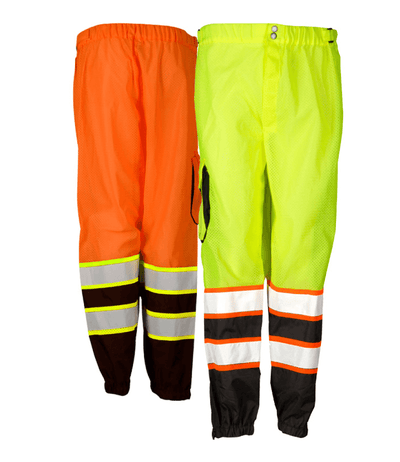From falling objects to toxic chemicals, various hazards abound in any kind of workplace. In the U.S. alone, over 4,000 people died from work-related injuries in 2017, and around 20% of these fatalities occurred in the construction sector. With how grave this issue is, the Occupational Safety and Health Administration (OSHA) has required workers in different industries to wear personal protective equipment (PPE). Meeting these requirements can protect employees against all kinds of workplace hazards and prevent them from being a part of these dreadful statistics.
Before choosing a PPE set for you or your employees to wear on the job site, consider the kinds of hazards present as well as the specific types of PPE that you need. But first, let’s check out the basic definition and importance of PPE.
What is Personal Protective Equipment?
Personal protective equipment (PPE) refers to articles of clothing such as hard hats, goggles, respirators, protective hearing devices, foot protection, and bodysuits. These garments and accessories are specifically designed to protect wearers from accidents, injuries, infections, or any physical harm that workplace hazards may cause.

Employees in any industry can wear PPE, but some of the most common industries that follow this type of safety protocol are mining, healthcare, and construction. Aside from employees, anyone who has to enter hazard-filled job sites should wear PPE.
Without PPE, work-related injuries and fatalities may skyrocket. Currently, some of the leading causes of fatalities in workplaces are falls, getting struck by objects, electric shocks, and getting compressed between equipment and structures. These occurrences are as horrible as they sound, but as long as workers are equipped with PPE, such accidents can be prevented.
In other words, wearing PPE is one of the best precautionary measures that everyone in the company can follow. Doing so increases the overall safety of the working environment.
Assessing Hazards
Before selecting the PPE set for employees to wear, employers must assess the types of hazards present in the workplace. By surveying the area for any source of risk to safety, companies will know what kinds of hazards to be cautious of and how to prevent injurious and fatal accidents from happening. Basically, the kinds of hazards to look out for are physical, mechanical, electrical, chemical, radiological, and biological hazards.
Physical hazards include ergonomic hazards that may result in repetitive strain injuries, extremely hot or cold temperatures that may affect the workers’ health conditions, noise hazards that may cause hearing loss, and vibration hazards that come from heavy machinery.
Mechanical hazards refer to those that are caused by machines and tools. Some examples of this type of hazard are getting snagged by or entangled in a moving part of the machine, getting shot by nail guns, or getting stabbed by sharp objects. These hazards are mostly found on construction sites, which are usually filled with various heavy equipment and tools.
Electrical hazards come from electrical currents in energized equipment, wiring, and cords. Machinists and electricians are commonly affected by these hazards. Short circuit, arc flashes, and current overload are some examples of electrical hazards, which may consequently result in electrocution or burns.
Exposure to chemicals, especially without masks, bodysuits, gloves, and other protective clothes, may result in severe or long-term illnesses and conditions. Common sources of chemical hazards are acids, fumes, and flammable materials, which typically exist in laboratories.
Different diseases, such as skin conditions and even cancer, are the usual consequences of radiological hazards. These hazards are brought about by radioactive chemicals found in contaminated water, air, or soil or in nuclear plants.
Hospitals and clinics are normally filled with biological hazards, which explains why doctors, nurses, and other hospital staff members have to wear masks when entering the rooms of patients. These hazards are caused by viruses, bacteria, and other microorganisms, which are passed from one person to another through blood or other infected materials.
Types of PPE
After identifying the hazards present in the workplace, employers can then choose the PPE set that can properly protect employees against these hazards. Every safety garment and accessory should be constructed and designed with comfortable materials that comply with OSHA and ANSI standards. For instance, those working near arc flash hazards should wear fire-resistant modacrylic clothing with a certain arc rating.
Of course, PPE clothing should perfectly fit each employee. Loose-fitting clothes may expose wearers to harsh elements or may endanger wearers working near heavy machinery, which may snag them anytime. Tight-fitting clothes, on the other hand, are not only uncomfortable, but they also reduce proper airflow and may cause employees to feel unwell in hot and humid environments. Apart from these, poor-fitting clothes can discourage employees from wearing them.
Each kind of PPE corresponds to the type of hazard that is prevalent in the working environment. It may cover one body part or may be combined with other garments and accessories, depending on the level of protection that employees need.
1. Eye and Face Protection
Employees in many industries can significantly benefit from eye and face protection. It’s no question that the eyes and face have to be well-protected at all costs. Construction zones, for instance, are filled with all sorts of dust particles. Workers in these zones should thus wear protective goggles to shield their eyes from dust.

Aside from small dust particles, other examples of hazards to the eyes and face include wood chips flying off of lumber, corrosive chemicals in solvents, radiation generated by lasers, and blunt force from swinging ropes or chains. Without the appropriate protective equipment, workers may suffer injuries ranging from minor cuts to permanent blindness.
According to the eye protection standards of the American National Standards Institute (ANSI) or the ANSI Z87.1, safety spectacles, goggles, welding shields, or face shields should pass a series of tests to earn a certification. These tests include resistance to flame and corrosion, impact, and chemical and radiation exposure.
Before choosing the suitable eye and face protective equipment, it should be checked if it fits properly and comfortably, provides unobstructed sight and unrestricted movement, allows easy cleaning, and does not restrict the functions of other PPE.
2. Head Protection
It’s widely known that head injuries can be easily fatal, which is why wearing protective head equipment is a must. This is especially true in job sites where employees’ heads may get struck by falling debris or other objects, hit against exposed beams, or come in contact with exposed wires.
The most commonly used type of headgear is a hard hat or a protective helmet. The ANSI Z89.1-1986 classifies these helmets into three categories. The first one is Class A, which is designed to lessen the danger of electrical contact with low-voltage electrical conductors running at 2,200 volts. Next, Class B helmets are built to resist up to 20,000 volts from high-voltage electrical conductors. Lastly, Class C helmets do not feature electric shock resistance, but just like Class A and B helmets, they are designed to cushion the impact of falling objects.
Other than impact and electric shock resistance, hard hats should have the ability to resist water and withstand penetration by sharp objects. They should also offer wearers adjustability as well as options on headband or suspension replacement.
3. Foot and Leg Protection
Huge rolling barrels, sharp materials, or power tools can possibly injure the feet of employees. In addition to these hazards, slippery surfaces can cause slips and falls, hot surfaces can burn the soles of the feet, and current charges can flow through the feet. For this reason, workers should put on protective footwear before entering job sites filled with these kinds of hazards.
The ANSI standard for personal protective footwear or ANSI Z41-1991 requires all kinds of footwear to have a protective toe. They should also be capable of protecting the feet from impact and compression. Despite these requirements, different types of footwear offer different levels of protection.
Leggings, for instance, provide the lower legs and feet with protection against molten materials or sparks from welding metal. Metatarsal and toe guards protect the instep area and toes from impact and compression, so they are normally made of aluminum, fiber, plastic, or steel. Foot and shin guards can be worn with toe guards for additional protection. Lastly, safety shoes offer resistance to impact and heat, perfect for roofing and paving jobs. Some safety shoes also feature solid metal insoles for protection against punctures, while others are made with non-conductive materials for electric shock resistance.
4. Hand and Arm Protection
When the job site poses different hazards to the hands and arms, the most prudent solution to this problem is to wear hand and arm protection. Arm coverings, gloves, and finger guards can effectively protect wearers from various hazards, such as thermal or chemical burns, electric shocks, cuts, amputations, and harmful substances.
When selecting which type of protective hand and arm gear to wear, there are different factors that must first be considered. Chemicals being handled as well as the nature and duration of contact with these chemicals should be taken into consideration. Employers should also determine the specific areas of the body that need protection—whether these are arms, forearms, or hands. The protective hand and arm equipment must then meet the requirements for grips, thermal protection, size, and abrasion resistance.
Gloves, in particular, come in a variety of materials and designs. There are leather, canvas, rubber, coated fabric, or metal mesh gloves, and they offer protection against chemicals, liquids, heat, or electric shock.
5. Body Protection
While OSHA regulates the designs of machines and tools as well as the site layout, some of them cannot guarantee absolute safety. This is why it’s better to be covered from head to toe with protective body garments when working in hazardous environments. Some examples of protective body garments are vests, jackets, hazmat suits, laboratory coats, aprons, and overalls.
Companies should identify if there are hazards related to extreme temperature conditions, molten metals, arc flashes, and hazardous chemicals. After determining the hazards, they should then choose the safety clothing made of materials that can offer protection against certain hazards.
Paper-like fiber materials can make up disposable suits for protection against dust and splashes, while leather can withstand flames and dry heat. Those working with jagged or sharp materials should wear clothes made of closely woven cotton fabric. Compared to loosely woven material, closely woven cotton fabric is less likely to get snagged by sharp objects. In environments with erratic temperature levels, treated wool and cotton are the best materials for safety clothing. These materials can also provide wearers with protection against dust and abrasion. Rubber and neoprene garments are well-suited in laboratories and other areas with harmful substances as these clothes can resist particular chemicals. Modacrylic fabric offers flame retardant properties, which are suitable in areas with arc flash hazards.
There are also high-visibility clothes that allow wearers to be easily seen in settings with high-speed traffic, heavy machinery, and other struck-by hazards. This type of clothes complies with the ANSI/ISEA 107 standards for high visibility and feature brightly-colored background materials, reflective materials, and combined performance materials. High-visibility apparel is divided into different categories: Class 1 garments for off-road use, Class 2 for roadways with traffic moving at a rate below 50 miles per hour, and Class 3 for highways with fast-speed traffic. Class E garments refer to pants, bibs or overalls, and gaiters, and they can be combined with Class 2 vests, shirts, rainwear, or outerwear to make a Class 3 ensemble.
6. Hearing Protection
Employees exposed to noise from power tools, machines, and other sources may experience long-lasting hearing problems, such as tinnitus and hearing loss. They should thus be equipped with hearing protection, especially when their jobs entail prolonged exposure to the noise. In addition to the duration of noise exposure, employers must measure the decibels of the noise and find out the number of noise sources.
Earplugs are the most commonly used type of hearing protection. There are disposable earplugs made of foam, cotton, or wool. There are also reusable ones that can be molded to specifically fit the ears of each employee. Aside from earplugs, earmuffs can be used by those who need to seal their ears completely.
Buying a PPE Set
All things considered, employers must assess the risks present on the job site before selecting the most suitable PPE set. When surveying the area, the particular kinds of hazards to look out for are physical, mechanical, electrical, chemical, radiological, and biological hazards.
After establishing the existing hazards on the job site, employers must then choose the appropriate PPE set for their employees. There are various types of PPE, each of which offers various designs and materials to suit the needs of employees. The PPE set chosen by employers must have the ability to effectively protect employees against certain hazards.

Of course, wearing PPE at all times is vital in maintaining the overall safety of the job site. If the PPE sets have gotten worn or damaged, employees should immediately inform their supervisors of the need to replace or repair their PPE.
Here on Engineer Warehouse, there are various kinds of PPE from which you can choose. Have your employees wear one of the safety garments that we offer—they are guaranteed to provide the utmost safety and comfort.


















